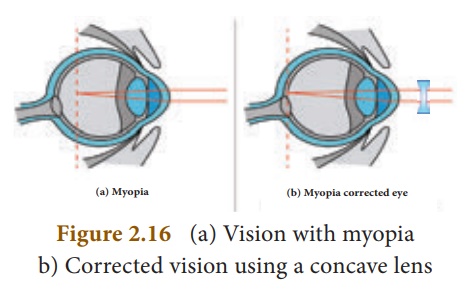Chapter: 10th Science : Chapter 2 : Optics
Defects in Eye
DEFECTS IN EYE
A normal human eye can
clearly see all the objects placed between 25cm and infinity. But, for some
people, the eye loses its power of accommodation. This could happen due to many
reasons including ageing. Hence, their vision becomes defective. Let us discuss
some of the common defects of human eye.
Myopia
Myopia, also known as
short sightedness, occurs due to the lengthening of eye ball. With this defect,
nearby objects can be seen clearly but distant objects cannot be seen clearly.
The focal length of eye lens is reduced or the distance between eye lens and
retina increases. Hence, the far point will not be infinity for such eyes and
the far point has come closer. Due to this, the image of distant objects are
formed before the retina (Figure 2.16-a). This defect can be corrected using a
concave lens (Figure 2.16-b). The focal length of the concave lens to be used
is computed as follows:

Let a person with myopia
eye can see up to a distance x. Suppose that he wants to see all objects
farther than this distance, i.e., up to infinity. Then the focal length of the
required concave lens is f = ŌĆōx. If the person can see up to a distance x and
he wants to see up to a distance y, then, the focal length of the required
concave lens is,
f = xy / x-y

Hypermeteropia
Hypermeteropia, also
known as long sightedness, occurs due to the shortening of eye ball. With this
defect, distant objects can be seen clearly but nearby objects cannot be seen
clearly. The focal length of eye lens is increased or the distance between eye
lens and retina decreases. Hence, the near point will not be at 25cm for such
eyes and the near point has moved farther. Due to this, the image of nearby
objects are formed behind the retina (Figure 2.17-a). This defect can be
corrected using a convex lens (Figure 2.17-b). The focal length of the convex
lens to be used is computed as follows:

Let a person with
hypermeteropia eye can see object beyond a distance d. Suppose that he wants to
see all objects closer than this distance up to a distance D. Then, the focal
length of the required convex lens is
F=dD / d-D

Presbyopia
Due to ageing, ciliary
muscles become weak and the eye-lens become rigid (inflexible) andso the eye
loses its power of accommodation.
Because of this, an aged
person cannot see the nearby objects clearly. So, it is also called as ŌĆśold age
hypermetropiaŌĆÖ.
Some persons may have
both the defects of vision - myopia as well as hypermetropia. This can be
corrected by ŌĆśbifocal lensesŌĆÖ. In which, upper part consists of concave lens
(to correct myopia) used for distant vision and the lower part consists of convex
lens (to correct hypermetropia) used for reading purposes.
Astigmatism
In this defect, eye
cannot see parallel and horizontal lines clearly. It may be inherited or
acquired. It is due to the imperfect structure of eye lens because of the
development of cataract on the lens, ulceration of cornea, injury to the
refracting surfaces, etc. Astigmatism can be corrected by using cylindrical
lenses (Torrid lenses).
Related Topics